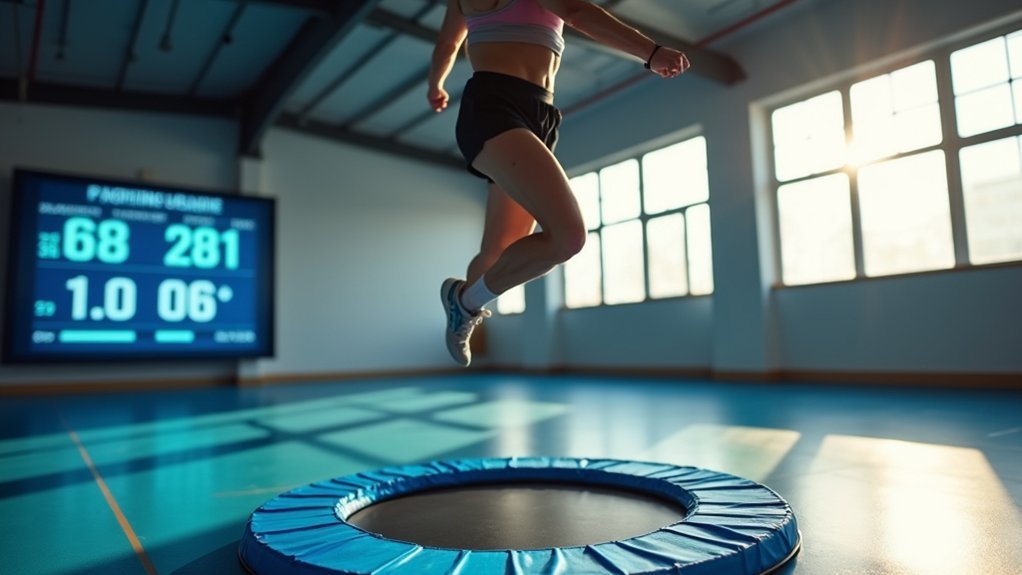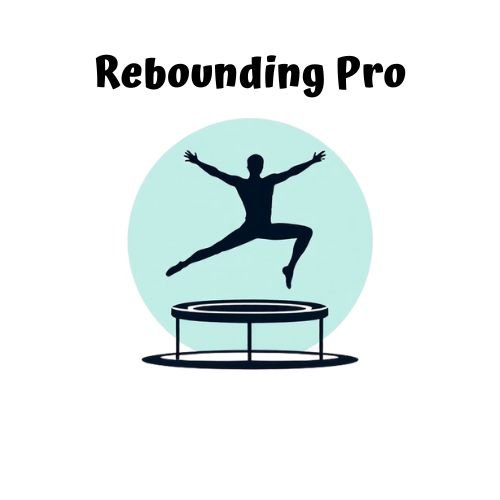The calories-to-intensity ratio in jump workouts connects effort level (measured in METs) to your calorie burn. Lower intensities (8.8 METs) deliver steady calorie expenditure, while vigorous jumping (12.3+ METs) considerably increases burn rates. Your body weight matters too—heavier individuals burn nearly twice as many calories during identical workouts. You’ll burn between 6.9-12.4 calories per minute rebounding, similar to jogging but with less perceived exertion. The right intensity combinations reveal your maximum fat-burning potential.
What the Calories-to-Intensity Ratio Really Means for Jumpers

When you step into the world of jump workouts, understanding the calories-to-intensity ratio becomes your key to maximizing results. This relationship directly connects your effort level (measured in METs) to your calorie burn.
At its core, the ratio reveals how efficiently you’re converting energy during jumps. Lower intensities (around 8.8 METs) provide steady calorie burn, while vigorous jumping (12.3+ METs) considerably increases your expenditure. Your body weight also factors in—heavier individuals naturally burn more calories at the same intensity level.
This ratio isn’t just numbers—it’s a practical tool. By manipulating intensity through faster jumping rates or weighted ropes, you’ll burn more calories in the same time frame. The typical jumping rate of 100-120 skips/minute serves as an excellent baseline for most fitness enthusiasts.
Understanding this relationship helps you design workouts that align perfectly with your specific fitness goals.
The Science of MET Values in Rebounding Exercise
To fully grasp the effectiveness of jump workouts, you’ll need to understand the science behind MET values in rebounding exercise.
MET (Metabolic Equivalent of Task) measures intensity relative to your resting state, with rebounding typically achieving a substantial 7.2 METs—meaning you’re burning 7.2 times more calories than at rest.
Calculating your calorie burn involves a simple formula: (MET × 3.5 × weight in kg ÷ 200) × duration in minutes. Your bounce intensity dramatically affects these values, with vigorous rebounding potentially reaching 11.3 METs. Research shows that men burn approximately 12.4 calories per minute during mini-trampoline workouts, while women average about 9.4 calories per minute.
Beyond calories, these MET levels deliver impressive physiological benefits: improved cardiovascular endurance, enhanced muscular strength, better balance, and increased bone density.
For best results, aim for three 20-45 minute sessions weekly, adjusting intensity through duration and technique.
Measuring Calorie Burn on Mini-Trampolines vs. Jump Ropes

When comparing mini-trampolines to jump ropes, you’ll find that jump ropes deliver more calories burned per minute (10-16 calories) than trampolining (around 6-7 calories).
Your trampolining sessions need to last longer to match the caloric output of jump rope workouts, though they offer the advantage of lower impact on your joints.
The intensity-to-results ratio favors jump rope for quick calorie burning, while mini-trampolines provide a more sustainable option for longer, joint-friendly workouts that still effectively combat gravity’s resistance. Jump rope is widely considered more beneficial for weight loss due to its higher caloric expenditure in shorter time periods.
Mini-Trampoline Energy Efficiency
Despite their seemingly playful nature, mini-trampolines offer impressive calorie-burning potential that rivals traditional high-intensity exercises. You can expect to burn between 6.9 and 12.4 calories per minute during a rebounding session, with a 40-minute workout potentially burning around 405 calories for a 140lb person.
Your weight considerably impacts calorie burn—heavier individuals expend more energy during identical workouts. For precise tracking, consider using heart rate monitors or online calculators that factor in your specific metrics.
The energy efficiency of mini-trampolines can be maximized by varying your routine and incorporating different movements to engage multiple muscle groups. Research shows that rebounding provides numerous health benefits beyond calorie burning, including improved heart health, strength, endurance, and mood elevation.
When compared to jump ropes, rebounding offers similar calorie-burning benefits but requires slightly more space and investment, though both are effective for weight management.
Calorie Comparison Metrics
Direct comparison of mini-trampolines and jump ropes reveals significant differences in calorie-burning efficiency between these popular jump exercises.
When you’re weighing exercise options based on calorie expenditure, you’ll find jump rope delivers more substantial burn in shorter periods. While jump rope is more intense, rebounding provides low-impact workouts that are much gentler on the joints.
The numbers tell a clear story:
- Jump rope burns 200-300 calories in 30 minutes, while trampolining burns 160-200 calories in the same timeframe.
- High-intensity trampoline workouts can reach 470 calories per 30 minutes, comparable to running at 8 mph.
- Per minute, jump rope burns an impressive 10-16 calories, making it extraordinarily time-efficient.
You’ll get more caloric burn from jump rope in quick sessions, but trampolines offer sustainable, joint-friendly workouts that may allow for longer exercise durations and better adherence to your fitness routine.
Intensity-to-Results Ratio
The intensity-to-results ratio reveals critical differences between jump rope and mini-trampoline workouts that go beyond simple calorie counts.
While both activities deliver high caloric expenditure, their impact varies considerably.
Jump ropes offer superior Reactive Strength Index improvements, engaging more muscle groups simultaneously with minimal equipment.
You’ll experience greater power output development due to the direct ground contact and neuromuscular coordination requirements.
Mini-trampolines provide a gentler approach with reduced injury risk while still maintaining effective caloric burn. The effectiveness of these exercises depends significantly on proper form and technique, similar to how depth jumps require correct execution to prevent injury and optimize training outcomes.
They’re particularly valuable if you’re managing joint issues but still want intensity benefits.
Your choice should align with specific goals: choose jump ropes for maximum explosive power development and caloric burn, or mini-trampolines when seeking lower-impact options that still deliver cardiovascular benefits and muscle engagement.
How Body Weight Affects Your Rebounding Calorie Expenditure

Your body weight considerably impacts how many calories you’ll burn during rebounding workouts, with heavier individuals generally expending more energy for the same exercises.
This increased calorie burn occurs because your body must work harder to move greater mass against gravity during each bounce on the mini-trampoline. High-quality rebounders amplify this effect by creating enhanced G-Force during your workout session.
Using weight-based calorie charts can help you accurately track your energy expenditure and set realistic fitness goals based on your specific body composition.
Weight-Based Calorie Charts
Understanding how your body weight influences calorie burn during rebounding workouts helps you set realistic fitness goals and track progress accurately. If you weigh more, you’ll naturally burn more calories during the same rebounding session compared to someone lighter. A 190-pound person might burn nearly twice as many calories as a 130-pound individual performing identical exercises. Like with other activities, specific weight categories significantly impact the number of calories burned during rebounding workouts.
Weight-specific calorie charts provide valuable insights for tailoring your rebounding routine:
- Customize intensity levels based on your current weight to maximize calorie expenditure
- Track your progress as your weight changes by adjusting calorie burn expectations
- Set achievable goals using personalized calculations rather than generic estimates
For precise tracking, use specialized calculators that factor in your weight, rebounding intensity, and workout duration to determine actual calorie burn.
Heavier, Higher Burn
Body weight plays an essential role in determining how many calories you’ll burn during rebounding workouts. The heavier you are, the more energy your body expends during each bounce, leading to higher calorie burn rates. This occurs because your muscles work harder to move greater mass against gravity. The basic formula for calculating calories burned considers your exercise intensity (MET) along with body weight and duration of activity.
| Weight (lbs) | Calories/30 min | Intensity Level |
|---|---|---|
| 150 | 420 | Moderate |
| 180 | 503 | Moderate |
| 210 | 587 | Moderate |
When you customize your rebounding routine to your weight, you’ll optimize your fitness results. While lighter individuals burn fewer calories per session, everyone benefits from the full-body muscle engagement that rebounding provides. As you continue with consistent practice, you’ll likely increase your jumping speed and intensity, further enhancing your calorie expenditure regardless of your starting weight.
Optimizing Bounce Rate for Maximum Calorie Burn
While many exercisers focus solely on workout duration, the strategic manipulation of bounce rate during jump workouts can dramatically increase calorie expenditure. Your jumping frequency directly influences heart rate and metabolic demand, creating opportunities to maximize your rebounding efficiency.
The science is clear: manipulating your bounce rate is the hidden key to unlocking maximum caloric burn during rebounding sessions.
To optimize your bounce rate for calorie burning:
- Alternate between rapid-fire jumps (30-60 seconds) and controlled recovery bounces to trigger the afterburn effect without premature fatigue.
- Find your sustainable intensity sweet spot by balancing bounce height with frequency—too high can shorten your workout, while too slow won’t challenge your system.
- Incorporate bounce rate variations within your routine by switching between quick, shallow jumps and moderate, deeper rebounds to prevent muscle adaptation.
- Heavier individuals can expect to burn more calories during their trampoline sessions due to increased energy exertion required to propel body weight against gravity.
Rebounding Workout Intensity Levels: Beginner to Advanced
As you progress through your rebounding journey, the intensity of your workouts should evolve to continuously challenge your body and maximize calorie burn. Each level brings increased demands and caloric expenditure as you develop coordination and strength. Rebounding can burn approximately 9.4 calories per minute, making it comparable to more high-impact activities while being gentler on joints.
| Level | Characteristics | Duration | Weights | Intensity |
|---|---|---|---|---|
| Beginner | Gentle bouncing, minimal elevation | 10 min | None | Light effort, focus on balance |
| Intermediate | Increased height, faster rhythm | 20 min | Optional light weights (1-2 lbs) | Moderate effort with basic arm movements |
| Advanced | Explosive movements, maximum height | 20+ min | Weights (1-3 lbs) recommended | Vigorous effort with complex movements |
| Progression | Increase duration/intensity by 10% weekly | Varies | Add weights progressively | Monitor heart rate and perceived exertion |
| Adaptation | Adjust based on fitness goals | Flexible | Scale according to strength | Customize for weight loss or endurance |
Time-Efficient Rebounding: Getting More Calories Burned in Less Time
Now that you understand the intensity spectrum of rebounding workouts, let’s focus on maximizing your calorie burn in minimal time.
Even brief 15-minute sessions can greatly impact your daily calorie expenditure, with a 155-pound person burning approximately 7.43 calories per minute during moderate rebounding.
To optimize your time-to-calorie ratio:
- Incorporate HIIT intervals – Alternating between high and low intensity dramatically increases calorie burn without extending workout duration.
- Add variety to movements – Mix in high knees, jumping jacks, and twist jumps to engage more muscle groups simultaneously.
- Use resistance elements – Integrate light weights or resistance bands to elevate the metabolic demand of your workout.
Creating consistent rebounding routines can help you achieve calorie deficit necessary for effective weight loss while improving cardiovascular fitness.
The Metabolic Impact of Different Rebounding Techniques
Different rebounding techniques affect your body’s metabolic responses in unique and powerful ways. The basic bounce activates your lymphatic system even without your feet leaving the mat, while thirty minutes can burn more calories than running with less joint impact.
You’ll maximize metabolic benefits by incorporating variety. High-intensity interval training greatly elevates oxygen consumption and calorie burn compared to steady bouncing. Adding resistance bands or light weights intensifies muscle engagement and increases post-exercise metabolism. Continual bouncing movement is especially effective for weight loss goals, creating sustainable fat-burning results.
For immune support, just two minutes of gentle rebounding hourly can nearly triple white blood cell count while flushing your entire lymphatic system.
The technique you choose matters—lateral movements and agility drills increase exercise intensity through complex motor activity, challenging different metabolic pathways than standard bouncing.
Tracking Intensity: Heart Rate Zones During Rebounder Sessions
Tracking your heart rate during rebounder workouts provides critical insights into your exercise intensity and helps maximize calorie burn.
By monitoring which zone you’re in—from Zone 1 (very light) to Zone 5 (maximum effort)—you’ll guarantee your training aligns with your fitness goals.
Heart rate zone tracking ensures your rebounder workout perfectly matches your fitness objectives with every bounce.
For ideal results on a rebounder, understand these key zone benefits:
- Zone 2 (60-70% MHR): Perfect for steady-state cardio, enhancing fat metabolism and building aerobic fitness without excessive fatigue.
- Zone 3 (70-80% MHR): Supports fitness maintenance with manageable cardiac strain, ideal for intermediate users.
- Zones 4-5 (80-100% MHR): Pushes your cardiovascular system to its limits during HIIT sessions, dramatically improving endurance and maximizing calorie expenditure.
Incorporating dynamic movements like jumping jacks and scissors during your warm-up helps prepare your body for higher intensity zones and engages multiple muscle groups.
Use heart rate monitors or RPE scales to stay on target throughout your session.
Why Rebounding Burns Calories Without Feeling Like Hard Work
While monitoring your heart rate opens up ideal training zones, you might wonder why rebounding feels easier than other workouts with similar calorie burn. The answer lies in rebounding’s unique biomechanics.
When you bounce, your effective body weight momentarily increases, burning more calories without feeling like hard work. Studies show you’ll burn between 6.9-12.4 calories per minute, comparable to jogging, yet perceived exertion is about 10% lower.
The springy surface absorbs shock, reducing muscle fatigue and making the workout feel less strenuous. NASA research confirms rebounding’s biomechanical efficiency – your body experiences gentle acceleration forces under 4-G’s, optimizing energy use while minimizing joint stress. The low-impact exercise qualities of rebounding allow even those with joint concerns to participate without exacerbating existing conditions.
This combination of efficient energy expenditure and enjoyable movement explains why you can torch calories without feeling exhausted.
Creating High-Burn Interval Routines on Your Rebounder
You’ll maximize calorie burn by alternating 30-second high-intensity jumps with 15-second recovery periods on your rebounder.
Adding sand weights or weighted gloves during basic bounce patterns can double your workout’s effectiveness while targeting upper body strength.
Track your caloric output using a heart rate monitor to maintain the ideal 75-85% of maximum heart rate zone where fat burning peaks. According to demonstrated results, a properly structured rebounding workout can burn approximately 393 total calories in a 44-minute session.
HIIT Intensity-Rest Alternations
Designing effective HIIT routines on your rebounder requires strategic planning of work-to-rest intervals to maximize caloric burn. The most efficient ratios typically involve 40 seconds of intense jumping followed by 15-20 seconds of recovery, creating the metabolic disruption that leads to enhanced calorie expenditure both during and after your workout.
To create your own high-burn rebounder HIIT session:
- Start with a Tabata-style approach using 40 seconds of work and 20 seconds of rest for 8 rounds.
- Incorporate active recovery periods with light bouncing instead of complete stops to maintain elevated heart rate.
- Progressively increase intensity by shortening rest periods from 20 to 15 seconds as your fitness improves.
Many effective trampoline workouts combine structured intervals of 10 and 20 seconds with longer one-minute segments to vary intensity and prevent workout plateaus.
Monitor your heart rate throughout to verify you’re working at peak intensity—aim for 70-85% of your maximum during work intervals.
Weighted Rebounder Techniques
Adding weights to your rebounder routine transforms a standard bounce workout into a high-intensity calorie-burning powerhouse.
Light hand weights during basic bounces engage your upper back and shoulders, while twist jumps with weights activate your core, obliques, and lower back.
For maximum calorie burn (8-12 calories per minute), structure your workout with 30-60 second weighted intervals alternated with low-intensity recovery bounces.
Maintain soft landings and proper posture to optimize muscle recruitment while preventing joint stress.
Try combining weighted squats with rebounds to enhance leg strength, or incorporate side-to-side movements for lateral stability. Performing the weighted squat technique requires keeping your back straight throughout the movement for optimal form and safety.
The key is fluid shifts between exercises, keeping your heart rate elevated while engaging multiple muscle groups simultaneously.
Remember to engage your core throughout to stabilize your body during higher-intensity jumps.
Tracking Caloric Output
To maximize your rebounder workout’s effectiveness, understanding the precise caloric output is essential for creating targeted high-burn routines.
Use the formula: kcal = (METs × 3.5 × weight in kg / 200) × minutes to estimate your burn. A 70kg person jumping at 11.8 METs for 10 minutes burns approximately 145 calories. Your body may experience both strength and weakness during intense rebounding sessions, similar to emotional contrasts in physical exertion.
For ideal calorie-burning intervals, structure your sessions with these high-intensity patterns:
- 2:1 Work-Rest Ratio – Implement 40 seconds of vigorous jumping followed by 20 seconds rest to maintain METs above 10 throughout your session.
- Progressive Intensity – Aim for 5-10% weekly increases in total jumps or sustained METs.
- HIIT Efficiency – Ten-minute routines with maximum effort intervals balance intensity with sustainability (aim for ~100 jumps per minute).
Equipment Considerations: How Rebounder Quality Affects Intensity
When selecting a rebounder for jump workouts, the quality of your equipment directly influences both calorie burn and workout intensity. The tension of your rebounder is essential—firmer surfaces demand more energy to bounce back, increasing muscular effort and calorie expenditure.
Your body weight matters too. Heavier individuals need rebounders with higher weight capacities and appropriate tension to prevent “bottoming out” while maximizing intensity.
Bungee cord systems typically offer quieter, more forgiving workouts than metal springs, reducing joint stress and allowing longer sessions. Expert testing shows that high-quality materials contribute significantly to the durability and consistent performance needed for effective calorie-burning workouts.
Don’t overlook surface area—larger rebounders enable a wider range of movements and jump variations. A stable frame prevents energy loss, ensuring your effort translates to actual calorie burn rather than compensating for wobbliness.
Your equipment’s quality ultimately determines how efficiently you can sustain high-intensity jumping sessions.
Sustainable Rebounding Practices for Long-Term Fat Loss Success
Sustainable weight loss through rebounding requires more than sporadic jumping sessions—it demands a thorough approach that balances consistent exercise with thoughtful nutrition and lifestyle changes.
You’ll need to embrace “consistency before results” while integrating rebounding into your broader fitness journey.
For lasting success, focus on:
- Dietary sustainability – Incorporate meatless days, prioritize nutrient-dense foods, and practice mindful eating to maintain your calorie deficit without feeling deprived. Replace sugary drinks with water to eliminate liquid calories and support your weight management efforts.
- Progressive rebounding – Commit to at least 15 minutes daily, gradually increasing intensity and mixing in HIIT or strength training elements.
- Adaptive monitoring – Track your calories, take progress photos, and adjust your workouts when you plateau.
Frequently Asked Questions
Does Jumping Rope Affect Joint Health Differently Than Rebounding?
Yes, while both are low-impact, jumping rope places more stress on your joints than rebounding. You’ll experience less impact with rebounding due to the trampoline’s spring mechanism absorbing much of the force.
Can Jump Workouts Replace Strength Training for Muscle Definition?
No, jump workouts can’t fully replace strength training for muscle definition. You’ll gain some lower body muscle tone and neural adaptations, but you’ll need traditional resistance training for ideal hypertrophy and thorough muscle definition.
How Do Weather Conditions Affect Outdoor Jump Rope Calorie Expenditure?
Cold weather boosts your calorie burn during jump rope by triggering thermogenesis. You’ll burn more calories as your body works to stay warm, especially if you maintain high intensity and proper clothing.
Are There Effective Modified Jump Exercises for People With Injuries?
Yes, you can still benefit from modified jumping exercises if injured. Try water-based plyometrics, band-assisted movements, partial-range jumps, or isometric holds like wall sits to maintain strength while reducing joint stress.
Do Jump Ropes With Digital Counters Accurately Measure Calories Burned?
No, digital jump ropes typically don’t measure calories burned accurately. They count jumps well but can’t account for your weight, intensity level, or technique—all essential factors affecting actual calorie expenditure during your workout.
In Summary
Understanding the calories-to-intensity ratio for your jump workouts is your key to efficient fitness. You’ll burn more when you optimize your bounce rate and mix intervals on quality equipment. Don’t be fooled by how easy rebounding feels—your body’s working harder than you realize. By measuring your effort with MET values and adjusting for your weight, you’re setting yourself up for sustainable, enjoyable fat loss success.





Leave a Reply